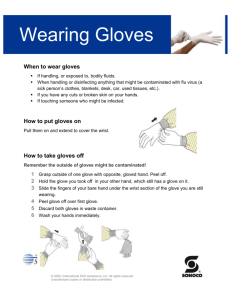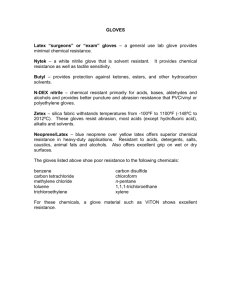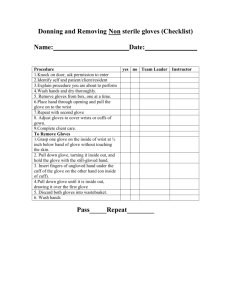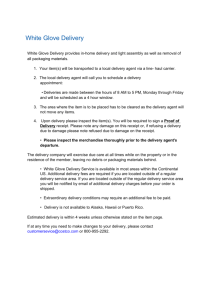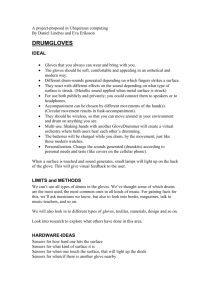Chemical Protective Gloves
advertisement
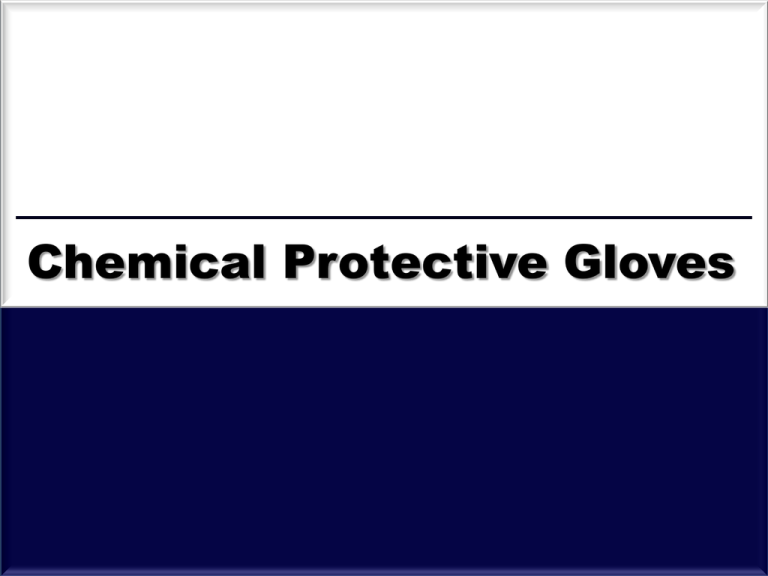
Chemical Protective Gloves Skin exposure to chemicals can lead to: Death Corrosion Irritation Poisoning Burns Chemical Allergies Many chemicals can be absorbed into the body through the skin. Such exposures can be very significant. Warning Any of the following poor practices can lead to chemical exposure: 1. Using the wrong glove; 2. Using a damaged glove; and/or 3. Using a glove that contains contamination Using the wrong gloves can be worse than not wearing gloves if the chemical is held against the skin. Any glove will protect me, right? No, the ability of a glove to prevent skin exposure depends on variables such as: 1. 2. 3. 4. 5. 6. 7. The chemical and it’s concentration The glove material Thickness of the glove material Duration of use Temperatures involved Pressure Holes or other damage to the glove material Common Glove Materials Glove Material Provides Protection Against Natural Rubber (latex) Polyvinyl Chloride (PVC) Bases, alcohols, & dilute aqueous solutions Acids, bases, & water solutions Butyl Rubber Glycol ethers, ketones, & esters Nitrile Oils, greases & aliphatic chemicals Neoprene Oxidizing acids & glycol ethers Polyvinyl Alcohol (PVA) Aliphatics, aromatics, chlorinated solvents, esters, ethers, and ketones (other than acetone) Laminate Film (e.g. Silver Shield) Almost any chemical Fluoro-elastomer (Viton) Aromatics, chlorinated solvents, aliphatics, & alcohols www.cdc.gov/od/ohs/manual/pprotect.htm Coverage Gloves should be long enough to protect the skin from contacting the chemical(s). Be sure to consider splash scenarios. If gloves of sufficient length can’t be found and additional skin coverage is needed, then other protective equipment such as aprons, arm sleeves, etc. can be worn. Selection Criteria To select the right glove you need to know: 1 . The chemical(s) to which the glove may be exposed; 2. Whether chemical exposure will occur by immersion or splash; 3. Anticipated duration of glove contact with the chemical; 4. How much coverage is needed. 5. Temperature and pressure Size, dexterity, and comfort are also important. Example Info Use Parameters: Chemical = Acetaldehyde Exposure type = Immersion Exposure Duration = 28 minutes Finger Immersion in Chemical Bath Natural Temperature and Pressure With this information you could cross reference the manufacturer’s literature (e. g. glove chart) to determine what glove is appropriate, and how long to use the glove. Manufacturer Websites Many manufacturers have information available for the gloves they produce. Links to access manufacturer information can be found on Risk Management’s website What if… There will be times when gloves are needed to protect against multiple chemical and there isn’t one type of glove that is suitable for all the chemicals. When this is the case consider wearing multiple types of gloves at the same time – one over the other. Replacement Chemicals permeate glove materials over time. Once the chemical reaches the other side “breakthrough” has occurred. Manufacturers provide breakthrough times for their gloves. Replace gloves before breakthrough occurs. Not doing so can lead to harmful exposure. Never use a damaged glove. Replacement Thin walled gloves need to be disposed of after one use. And, if used for splash protection, they need to be replaced immediately after being splashed. Thin walled gloves are typically used for splash protection, or to protect against contact with dry solids. Never use a damaged glove. Nitrile or Latex? Some proteins in natural latex can cause mild to severe allergic reactions, therefore nitrile is preferred over latex. Air Test Gloves Before Use 1.Fill the glove with air, manually or with an inflator; 2.Once inflated, check the glove for leakage by holding the glove closed and squeezing; and 3.Listen for escaping air or feel the glove for any air releasing. www.elcosh.org Always check chemically protective gloves for holes before use. Please share this presentation with your co-workers. -End-
